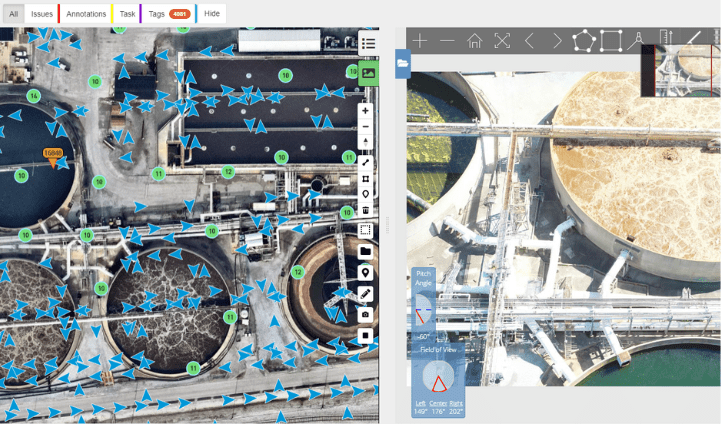Introduction
From telecom and manufacturing to power utilities and commercial roofing, drones are revolutionizing the way organizations approach asset inspection by, offering a blend of safety, efficiency, and precision that was previously unattainable. In turn, this has led to skyrocketing drone usage in commercial applications. In 2012, annual commercial drone activity was worth $40 million, according to analysts at McKinsey & Co. By 2026, it will be over $40 billion. By 2030, $77 billion.
This surge in drone adoption is driving a parallel increase in the volume of data generated. The sheer amount of visual and sensor data collected by drones can be overwhelming, necessitating robust data management solutions that can handle this data influx effectively. To reap the full advantages of drone data, organizations need access to measurement and analytics tools to take their asset management and inspection programs to the next level. As a result, organizations are now seeking platforms that not only facilitate seamless data collection and storage, but also offer intuitive tools for data analysis, reporting, workflow automation and collaboration.
However, the increase in drone data presents a major Big Data challenge for commercial organizations. Unless and until this challenge is solved, organizations will not be able to maximally capitalize on all the advantages drones offer, like safety improvements, high quality data, cost savings.
The Surge in Drone Technology Adoption
Industry Adoption
If we want to solve the Big Data challenge, first we need to understand why it’s worth it in the first place. Industries are leveraging drones to enhance their operational efficiencies, reduce costs, and improve safety protocols. The data collected by drones, often in real-time, provides invaluable insights that can be utilized for predictive maintenance, risk assessment, and strategic planning.
Benefits Drone Data Analysis for Inspection and Asset Management
Safety Improvements
Drones have significantly enhanced safety protocols by minimizing the need to place people in potentially hazardous inspection environments. Through aerial inspections, drones can easily access hard-to-reach or dangerous operating areas, reducing the risk of accidents and ensuring the safety of personnel.
As safety researchers stated plainly in the American Journal of Industrial Medicine, “[Drones] can perform dangerous tasks, thereby improving workplace safety.” The U.S. National Institute for Occupational Safety and Health (NIOSH) details why: drones can eliminate the risk of falls because personnel no longer have to engage in inspection activity at heights; prevent operator exposure to chemicals, toxins, and other dangerous environmental hazards; and minimize risks like ergonomic strain associated with reaching and fitting into otherwise hard-to-access spaces.
Enhanced Data Accuracy
Drones equipped with advanced sensors and cameras can capture high-resolution images and precise data, offering a level of accuracy that is typically superior to manual inspections. In one study, drone data collection was found to be up to 96% more accurate than typical, ground-based data collection approaches. This level of precision allows for more informed decision-making and helps in identifying potential issues before they escalate into service-impacting failures.
Cost-effectiveness
By automating inspection processes, drones help in reducing labor costs and operational expenses. Moreover, drones can complete inspections in a fraction of the time required for traditional methods, thus saving valuable resources and time. Drones also enable remote digital inspection of equipment and sites, reducing wasted travel time, travel costs, and enabling a geographically distributed workforce to assess assets globally. Whether it’s monitoring the health of assets or assessing the extent of damage after a natural disaster, drones can quickly provide a wealth of data, facilitating swift responses and actions based on accurate and complete assessments.
Speed and Efficiency in Data Collection
Drones have revolutionized data collection by offering rapid and efficient methods to gather comprehensive information. Whether it’s monitoring the health of assets or assessing the extent of damage after a natural disaster, drones can quickly provide a wealth of data, facilitating swift responses and actions based on accurate and complete assessments.
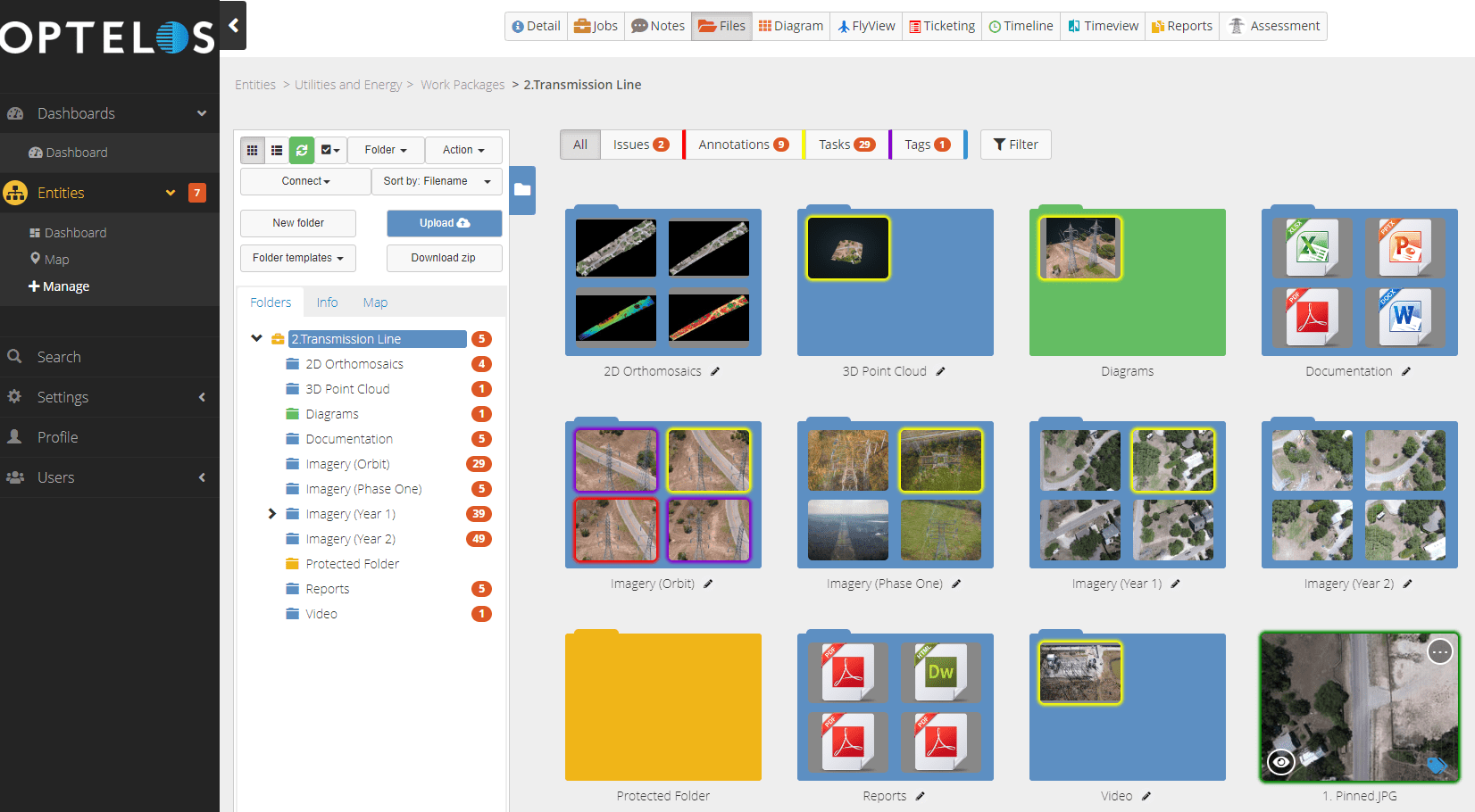
As a comprehensive drone data management and analytics platform, Optelos enables companies to automate the data collection, storage and analysis of drone captured imagery for full organizational leverage
The Growing Demand for Advanced Drone Data Management
Challenges Posed by Increased Drone Usage
As organizations increasingly rely on drones for inspection and asset management, many struggle with data overload. This surge in data volume presents a unique set of challenges, including fragmented data storage, data retrieval, and the need for specialized skills to analyze and interpret the data effectively. Moreover, the diverse formats in which drone data is captured necessitates a unified platform that can integrate and manage this data seamlessly, turning raw data into actionable insights.
Simply stated, if users cannot streamline drone data management, they will undercut – and perhaps even lose – the potential gains they could realize from adopting drones in the first place.
The Importance of Streamlined Drone Data Management
Enhancing Decision-Making Processes
Effective drone data management is not just about storing and organizing data; it plays a crucial role in enhancing the decision-making processes within organizations. By offering tools that facilitate the analysis and interpretation of data, management platforms can help organizations identify patterns and trends, enabling them to make informed decisions based on real-time insights. Custom dashboards are also valuable tools to organize routine asset status data by type, geography or inspection type, enabling quick review and identification of out of compliance equipment to deliver reliable customer service and safe working conditions.
Facilitating Collaboration and Communication
As drone data becomes more integral to organizational workflows, the need for platforms that foster and support collaboration and communication becomes apparent. Advanced data management solutions like Optelos offer features that allow teams to collaborate seamlessly, sharing insights via annotations, report templates and workflow automation to improve team efficiency and reduce mistakes.
Ensuring Regulatory Compliance and Data Security
With the growth in drone usage comes an increased focus on regulatory compliance and data security. Organizations are seeking platforms that not only help them adhere to regulatory standards but also ensure the security and integrity of their data. This includes features that facilitate data encryption, access control, and audit trails, safeguarding sensitive information and preventing unauthorized access.
As we navigate this complex landscape, the role of comprehensive and secure solutions like Optelos becomes increasingly significant. In the next section, we will explore how Optelos is positioning itself as a leader in the drone data management space, offering a range of features that address the challenges and needs of modern organizations.
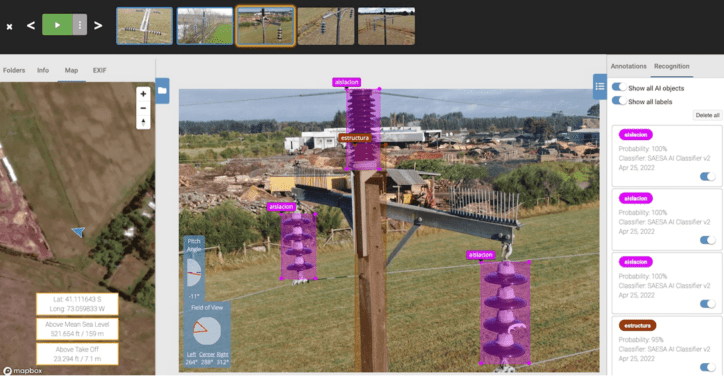
Manage the end-to-end AI process within Optelos. Upload, submit for AI processing, and receive annotated images within the platform within seconds. You can even annotate images and train the AI model within Optelos.
Optelos – A Comprehensive Solution for Drone Data Management
Overview of the Optelos Solution
In a landscape where asset condition and inspection data is growing at an unprecedented rate, Optelos stands apart as the most comprehensive solution, offering a platform that addresses the complexities of drone data management in innovative ways. Designed with a vision to integrate drone data seamlessly with asset inspection workflows with an unparalleled capability for easily handling massive files, Optelos transforms the way organizations approach data management by delivering capabilities for finding and accurately analyzing your data in a predictable and reliable manner, turning potential information overload into actionable insights and strategic decisions.
Key Features of the Optelos Platform
AI-Powered Analytics
AI-Ready Data Management: Optelos provides a unified database that facilitates the easy uploading and management of data for automated computer vision AI analysis, effectively eliminating data silos and parallel workflows with redundant data files. The Optelos platform supports data ingestion from a variety of sources, including robots, video cameras, and drones. With our open APIs, you can automatically upload your drone image data into Optelos, have it processed via Azure ML Studio or your desired AI provider with your computer vision AI algorithms for defect detection, then have the results fed back into Optelos. Images with detected defects can then be flagged for review and prioritization via workflow automation, or routed for ticketing and dispatch for issue resolution (depending on the accuracy of your algorithm).
Labeling and Annotation Tools: The platform offers integrated tools for data labeling and annotation, aiding in the creation of AI classifier models or the retraining/optimization of existing AI algorithms. It allows users to develop classification taxonomies within the platform, and improve them with new annotated datasets to increase the accuracy, thus streamlining the process of building, deploying, managing and improving AI algorithms by completing the actions within a single platform.
AI Model Training and Deployment: Optelos enables the testing and deployment of vision AI inspection models without the need for IT support. With the included annotation tools, Optelos supports the creation of new classifiers to identify asset types and fault conditions, facilitating more precise issue categorization.
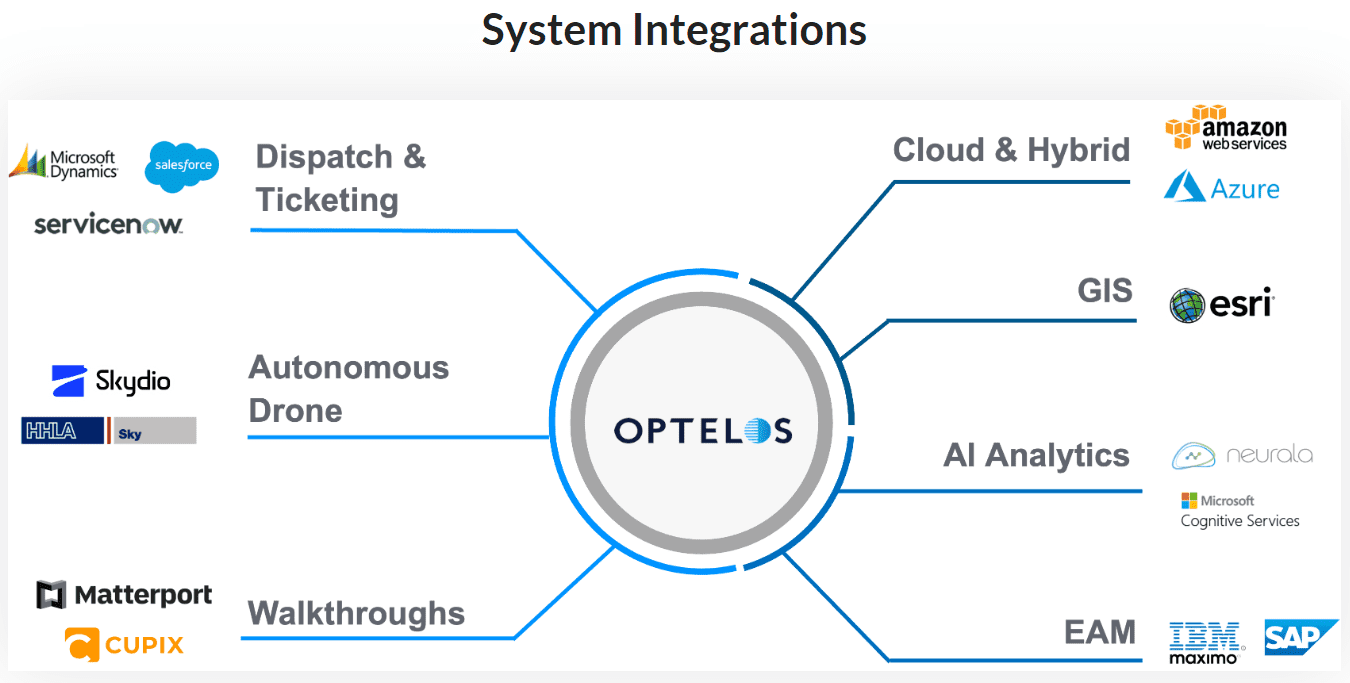
Optelos integrates with enterprise systems through open APIs, enabling further asset management workflow automation and sharing of asset inspection insights.
Systems Integrations
Open Architecture for System Integration: The platform boasts an open architecture that facilitates enterprise system integration, allowing for seamless collaboration and data sharing across various platforms. Optelos can be integrated with autonomous drones for automated data upload, walkthrough software such as Matterport and Cupix, cloud and hybrid data storage solutions like AWS and Azure, GIS systems such as Esri, AI analytics engines and EAM platforms such as IBM Maximo and SAP.
Ticketing and Dispatch Integration: Optelos integrates with existing ticketing and dispatch systems through its Open Data APIs, automating corrective actions identified through vision AI inspection and providing precise geolocation of all detected faults to speed up issue resolution.
Visual and Intuitive Digital Twin Inspection Software
Within the platform, Optelos offers the ability to store, open, and manipulate extremely large 3D digital twin inspection models of virtually any size (our largest models are 250 GB, and we can support larger models if needed). Optelos users can leverage the platform to create new 3D Digital Twin models, submitting their captured image data for photogrammetry processing via the Optelos solution.
Enhanced Collaboration and Reporting Tools
The platform fosters enhanced collaboration through secure data sharing and integrated file viewers and visualization tools. This saves remote and executive personnel time and money by removing the need to purchase additional software licenses of obscure software just for file viewing. It also offers customizable jobs and tasks, allowing for the creation of routine jobs integrated into team workflows, and monitoring of tasks and performance through reports and dashboards.
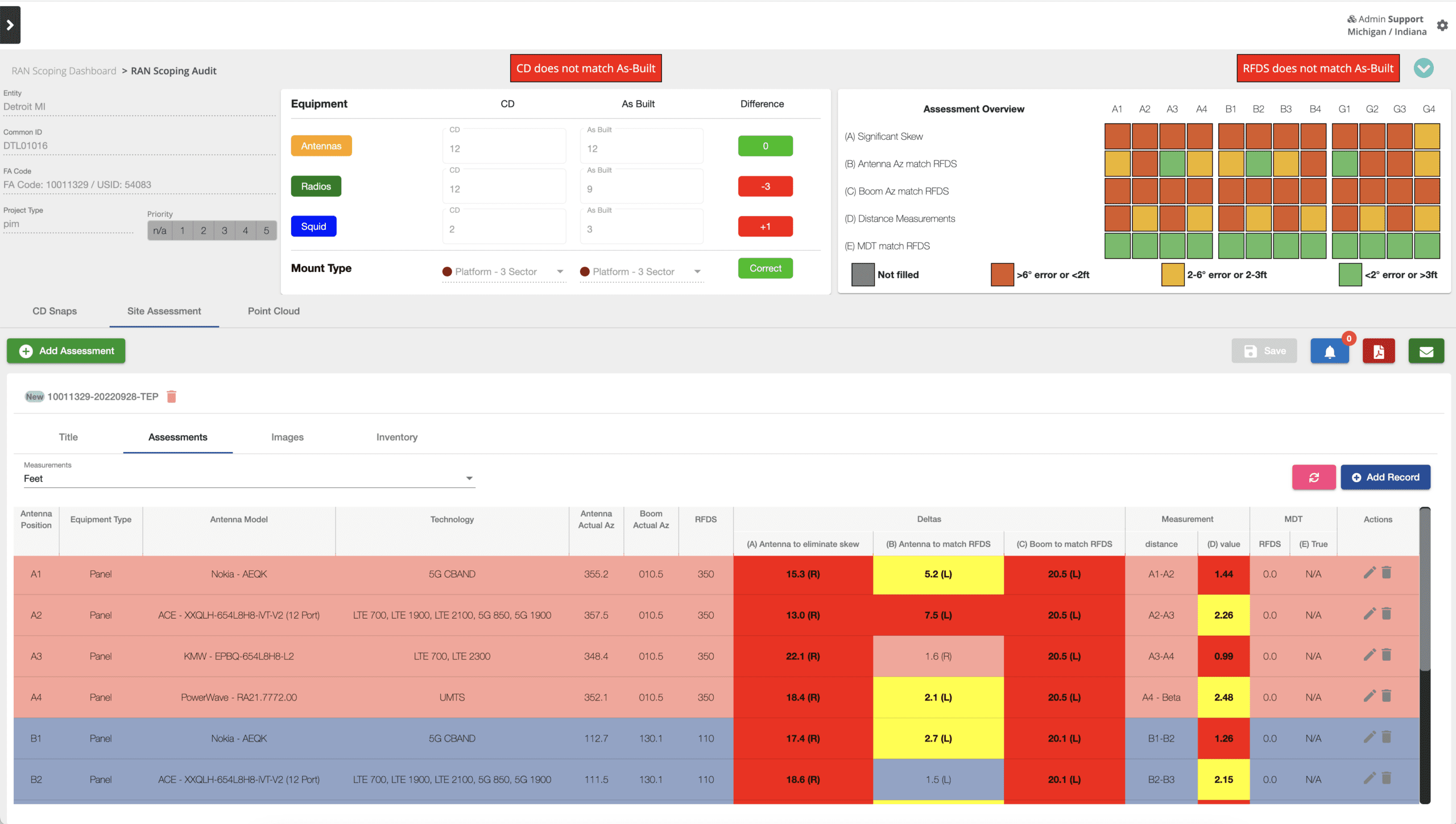
Reports and dashboards allow big data to transform asset inspections programs, summarizing overwhelming amounts of date into strategic insights of asset health by type and geography.
Looking Ahead
Using drones to collect inspection data about assets in real-time offers obvious benefits: the gains in speed, efficiency, accuracy, and cost savings are nothing short of phenomenal. However, without a solution in place to effectively manage the tsunami of new data, the organization will struggle to realize or optimize many of those gains.
Here, Optelos emerges as a front-runner, offering a solution that not only meets the current demands but also anticipates future challenges, ready-built to support your continued growth and increased adoption of new technologies. Through its comprehensive platform, Optelos is paving the way for organizations to navigate the complexities of drone data management with ease and efficiency.
If you would like to see how Optelos can ease your digital transformation journey, fill out the Contact Us form to request a demo, additional information, or a free consultation.
